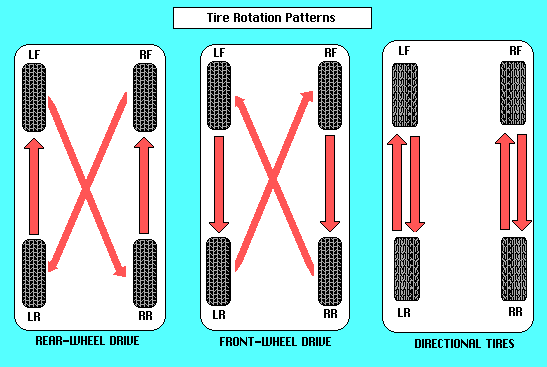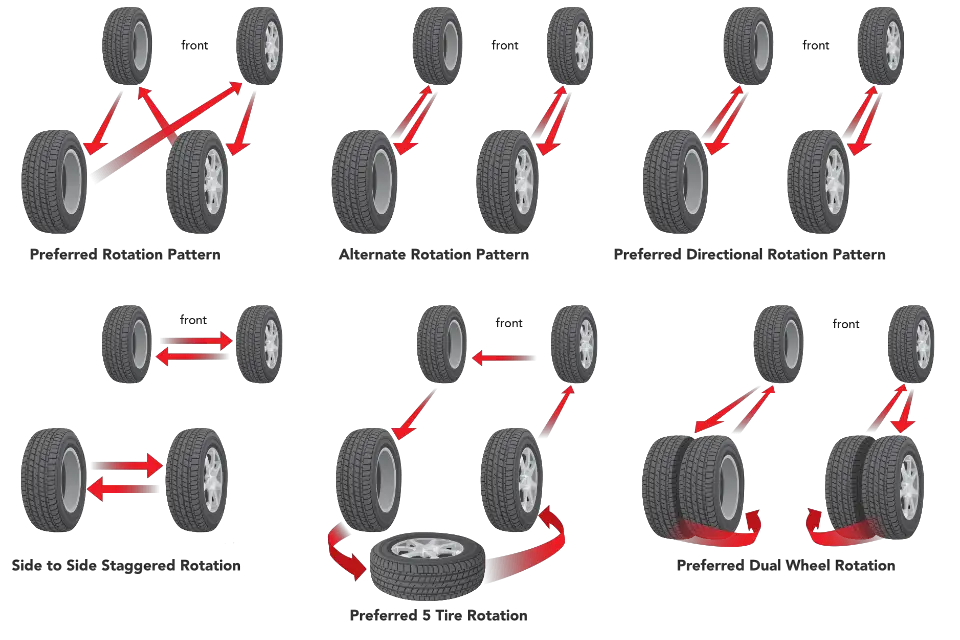Do new tires go on the front or rear? New tires should always be installed on the rear axle, regardless of whether your vehicle is front-wheel drive, rear-wheel drive, or all-wheel drive. This placement helps improve vehicle stability, especially in slippery conditions, and reduces the risk of oversteering.
When it’s time to replace the tires, you may wonder: should the new tires go on the front or rear? This is a common question among car owners, but understanding the right way to replace the tires is important for maintaining the safety and stability of the vehicle. The answer isn’t as straightforward as it might seem, and choosing the wrong placement for your new tires can impact the handling and safety of the car, especially in tricky driving conditions.
In this detailed guide, we’ll explore why tire placement matters, what to consider when replacing only two tires, and how to ensure the vehicle’s tires are in the best condition possible.

Contents
- 1 Why Tire Placement Matters?
- 2 The Importance of Tire Placement
- 3 Hydroplaning and Traction Loss: Why the Rear Tires Matter Most
- 4 Vehicle Over-steering vs. Under-steering
- 5 When to Replace Only Two Tires: Front or Rear?
- 6 Can I Mix Tire Brands and Types?
- 7 Does It Matter for AWD Vehicles?
- 8 How to Maintain Even Tire Wear: Tire Rotation
- 9 Frequently Asked Questions
- 10 Conclusion
Why Tire Placement Matters?
Tire placement plays a pivotal role in ensuring the vehicle’s stability. New tires tread depth is deeper, which provides better traction than older, worn-out tires. Where you place these new tires significantly affects how your vehicle handles, especially in wet or slippery conditions. While it may seem logical to place them where they will have the most direct contact with the road (such as the front for front-wheel-drive vehicles), tire experts suggest otherwise.
The Importance of Tire Placement
When it comes to replacing your tires, knowing the correct placement can significantly impact the safety and performance of your vehicle. Tire placement isn’t just about convenience, it’s about ensuring stability, especially under challenging road conditions like rain or snow.
Tire Wear Patterns and Vehicle Dynamics
Tires wear down over time due to friction, driving habits, and road conditions. Depending on your vehicle’s drivetrain (FWD, RWD, AWD), the wear patterns can vary. In a front-wheel-drive vehicle, the front tires are responsible for steering, braking, and powering the vehicle forward. This means that the front tires tend to wear out faster than the rear tires. In contrast, rear-wheel-drive vehicles place more strain on the rear tires, as the rear tires handle acceleration and traction.
No matter what drivetrain your vehicle has, tire wear can create imbalance in handling. If you place the new tires on the front in a front-wheel-drive vehicle, for instance, the older, worn-out tires on the rear will provide less traction. This imbalance could increase the likelihood of losing control, especially in wet or slippery conditions. To avoid this, it’s important to place the new tires on the rear axle, regardless of whether the vehicle is FWD, RWD, or AWD.
Hydroplaning and Traction Loss: Why the Rear Tires Matter Most
One of the biggest risks drivers face when driving on worn tires is hydroplaning. This occurs when a layer of water builds up between the tires and the road surface, causing the tires to lose traction. It’s much more dangerous when this happens to the rear tires rather than the front.
In the event of hydroplaning, the rear tires lose traction first, causing the vehicle to fishtail or spin out of control. On the other hand, if the front tires lose traction, the car will continue to move forward, and the driver can more easily regain control by easing off the accelerator or adjusting the steering. By placing the new tires on the rear, you ensure that the tires with the best traction are the ones that help keep your vehicle stable in these conditions.

Vehicle Over-steering vs. Under-steering
Understanding the difference between the over-steering and under-steering is crucial for maintaining control of your vehicle in slippery conditions. Whether you’re driving in rain or snow, the way your car responds to tire traction can affect how safely you can navigate the road.
- Under-steering: This happens when the front tires lose traction, and the car keeps going straight despite the driver turning the wheel. This is easier to control because the car tends to move forward rather than losing control.
- Over-steering: When the rear tires lose traction, the rear of the car can slide out, causing the vehicle to spin or fishtail. This situation is more difficult to control and can be more dangerous, especially at higher speeds.
By placing the new tires on the rear axle, you are minimizing the risk of oversteering and improving overall vehicle stability.
When to Replace Only Two Tires: Front or Rear?
Many drivers wonder if it’s okay to replace only two tires at a time rather than all four. The short answer is yes, but with certain conditions. When replacing only two tires, experts strongly recommend placing them on the rear axle. This applies even if your vehicle is front-wheel-drive, rear-wheel-drive, or all-wheel-drive.
Here’s why: when new tires are installed on the rear, they provide better control, preventing the rear of the vehicle from losing traction in slippery conditions. Placing the new tires on the front in an FWD vehicle may make sense because the front tires handle steering, but it compromises the vehicle’s overall handling by leaving the rear tires in worse condition.
Can I Mix Tire Brands and Types?
It’s generally recommended to avoid mixing tire brands or types (such as all-season and performance tires) on the same axle. If you do decide to replace only two tires, ensure they are of the same brand, type, and size as the other two to maintain balance. Having tires of varying conditions can cause uneven wear and affect vehicle handling, especially when cornering or during sudden braking.
Does It Matter for AWD Vehicles?
In all-wheel-drive vehicles, it’s crucial to replace all four tires at once. This is because AWD systems rely on all tires being the same size and tread depth to distribute power evenly. Installing new tires only on one axle can cause uneven rotation, damaging the drivetrain. In an AWD vehicle, always replace all four tires simultaneously to avoid unnecessary mechanical issues.
How to Maintain Even Tire Wear: Tire Rotation
To get the most out of your tires, regular tire rotation is key. Tire rotation ensures that all tires wear evenly and extend their lifespan. This is especially important when you have uneven tire wear due to driving habits or vehicle type.
It’s recommended to rotate your tires every 6,000 to 8,000 miles (ca. 12,875 km), depending on the manufacturer’s guidelines. Make sure to rotate them in the proper direction, especially if you have directional or staggered tires. If in doubt, always consult your vehicle’s manual for guidance.
Frequently Asked Questions
Here are some FAQs about tire placement –
1. Can I install new tires on the front if I have FWD?
While it’s common to install new tires on the front for front-wheel-drive vehicles, safety experts recommend installing them on the rear axle for optimal control and safety.
2. Is it safe to replace only two tires instead of all four?
Yes, but it’s significant to install the new tires on the rear axle, even if you have a front-wheel-drive vehicle. This helps maintain better control and reduces the risk of oversteering.
3. How can I tell if my tires need replacing?
Check the tread depth with a tire gauge. If the tread is below 2/32 of an inch, it’s time for new tires. Additionally, look for visible damage or uneven wear.
4. Do I need to replace all four tires on an AWD vehicle?
Yes, for all-wheel-drive vehicles, it’s crucial to replace all four tires at once to prevent drivetrain damage and ensure balanced handling.
5. Can I mix tire brands or types?
It’s not advisable to mix tire brands or types, as this can cause uneven wear and affect vehicle performance. Always replace tires in pairs or all four for the best results.
Conclusion
Always install new tires on the rear axle, regardless of your vehicle’s drivetrain. This is simple yet important step can dramatically improve the stability, handling, and safety of your vehicle, especially in adverse driving conditions.
By regularly rotating the tires, checking for wear, and replacing them at the appropriate time, you’ll ensure a smoother and safer ride for you and your passengers. Remember, maintaining tire balance and safety is essential for every vehicle owner. So, next time you’re due for a tire change, place those new tires on the rear and drive with confidence!